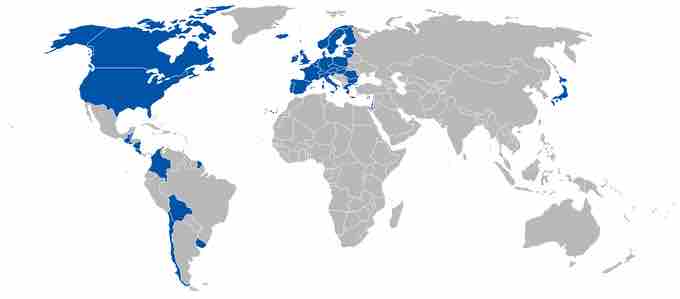Mexico's economy has undergone significant changes in the past century, with implications for the country's economic position and its population. After the Mexican Revolution (1910-1917) overturned the previous land distribution system, in which a few hacienda owners overworked and underpaid millions of peasants, the new Mexican leaders instituted a nominally socialist democracy. The years from 1930-1970, during which Mexico instituted its new protectionist economic policy, have been dubbed by economic historians as the "Mexican Miracle," a period of economic growth and capital accumulation. While population doubled from 1940 to 1970, gross domestic product (GDP), the sum of national production and a common measure of economic growth, increased sixfold during the same period.
After the international oil and interest rate crisis in 1982, which had a profoundly negative impact on the Mexican economy, Mexican leaders changed economic directions. They instituted neoliberal reforms which increasingly integrated Mexico's economy with that of other nations. Trade liberalization continued after that, with several free trade agreements with Latin American and European countries, Japan, and Israel signed during former President Vincente Fox's leadership (2000-2006). Thus, Mexico became one of the most open countries in the world to trade, and the economic base shifted accordingly to exports and imports .

Map of Mexican Free Trade Agreements
Since liberalizing its trade policies beginning in the 1980s, Mexico has entered into Free Trade Agreements with many countries. This trend has greatly increased the amount of Mexico's economy that depends on imports and exports.
Social Stratification, Poverty, and Unemployment
Mexico's economic development has been substantial. However, general GDP growth obscures some pervasive problems that have persisted and even worsened in recent years, including social stratification, poverty, and unemployment.
Social stratification, or the grouping of individuals into a hierarchy based on socioeconomic status, is highly present in Mexico and can be traced back to the colonial period. During the colonial period, before Mexico's independence, the upper class was composed of those who owned the land and the lower class was made of those who worked the land. After the Mexican Revolution, the government ceded an estimated 50% of the land to the general population. Though this slightly reduced the gap between the wealthy and the poor, land ownership continued to be main source of wealth for Mexicans and has dictated the hierarchy of wealth distribution among the population.
After the country entered its economic industrial transformation, industrialists, businessmen, and politicians have controlled the direction of wealth in Mexico and have remained among the wealthy. The monopoly that the wealthy have over resources in Mexico is evidenced in OECD statistics: Mexico is the country with the second highest degree of economic disparity between the extremely poor and extremely rich, after Chile, although this gap has been diminishing over the last decade. The bottom 10% of income earners possess 1.36% of the country's assets, whereas the upper 10% possesses almost 36%. 85% of national wealth is concentrated in a few families of entrepreneurs, corporate magnates, and politicians. Thus, economic industrialization has not necessarily led to an improved standard of living for a significant portion of the Mexican population, many of whom live in poverty.
The gap between the rich and poor has not only remained large between classes, but also has been growing between northern and southern regions. As reforms have taken place, the southern states, such as Chiapas, Oaxaca, and Guerrero, have remained isolated from the rest of the country. The national government provides less funding to these southern regions than to northern regions. Consequently, infrastructure, social development, education, and economic growth have lagged behind in southern states. These states hold the highest levels of illiteracy, unemployment, lack of basic services such as running water and sanitation, overall urban infrastructure, and government stability.
Poverty
Poverty in Mexico is characterized as lack of access to basic human needs such as nutrition, clean water, and shelter. Poverty can also include lack of access to extends to social services such as education, healthcare, security, and income. Current figures indicate that as much as 44.2% of Mexico's population lives below the poverty line as defined by the country's National Council of Social Development Policy Evaluation.
While causes of poverty are multiple, many social scientists have posited that the government's emphasis on national economic growth has neglected the needs of the country's poorer citizens. For example, Mexico's heavy dependency on foreign influences, particularly the United States, has led it to adopt policies that do not favor its own citizens. Similarly, many critics claim that while the NAFTA agreement proved effective in increasing Mexico's economic performance, foreign trade policies have not done enough to promote social advancement and reduce poverty. To remain competitive in the international market, Mexico has had to offer low wages to its workers while allowing high returns and generous concessions to international corporations. Nonetheless, the government's current administration has made attempts to reduce poverty by providing improved education, healthcare, and job opportunities to citizens. In recent years, a middle class, once virtually nonexistent, has begun to emerge.